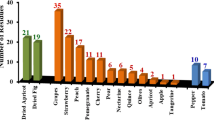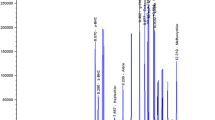Abstract
Fruits are the valuable and important components of human diet. Among them, Prunus persica is a rich source of different minerals and dietary fibers. In Pakistan, the total annual production of P. persica is approximately 837,000 tons. In order to enhance agricultural yield and quality, the plant protection agents are employed during fruit production. Ultimately, this in turn leads to the incorporation of pesticide residues in fruits. In present study, an effort has been made for the determination of three selected pesticide residues, i.e., chlorpyrifos (CPF), difenoconazole (DFN), and carbendazim (CRB) in samples of P. persica collected from Swat territory. Samples were analyzed through high performance liquid chromatography (HPLC). Results revealed the occurrence of all three pesticides in studied samples; however, levels of CPF and DFN were found to be higher than MRLs. Moreover, the effects of different mitigation techniques revealed that highest reduction of CPF, DFN, and CRB (86%, 97%, 89%) residues was obtained by treatment with 10% CH3COOH followed by 10% NaCl (74%, 78%, 84%). The lowest reduction was obtained by treatment with 10% solution of NaOH (52%, 55%, 63%).




Similar content being viewed by others
References
Baig SA, Akhter NA, Ashfaq M, Asi MR, Ashfaq U (2012) Imidacloprid residues in vegetables, soil and water in the southern Punjab, Pakistan. J Agric Technol 8(3):903–916
Bakırcı GT, Acay DBY, Bakırcı F, Ötleş S (2014) Pesticide residues in fruits and vegetables from the Aegean region, Turkey. Food Chem 160:379–392
Chandio AA, Yuansheng J, Magsi H (2016) Agricultural sub-sectors performance: an analysis of sector-wise share in agriculture GDP of Pakistan. Int J Econ Financ 8(2):156–162
Chen H, Liu X, Wang C, Wang Q, Jiang Y, Yin P, Zhu L (2013) Simultaneous determination of thiophanate-methyl and its metabolite carbendazim in tea using isotope dilution ultra performance liquid chromatography–tandem mass spectrometry. J Chromatogr Sci 52(10):1157–1164
Chu Z, Zhuang M, Li S, Xiao P, Li M, Liu D, Zhou J, Chen J, Zhao J (2019) Residue levels and health risk of pesticide residues in bell pepper in Shandong. Food Addit Contam A 12:1–8
Chung SW (2018) How effective are common household preparations on removing pesticide residues from fruit and vegetables? A review. J Sci Food Agric 98(8):2857–2870
EWG (2015) EWG’s 2015 shopper’s guide to pesticides in produce. Retrieved from: https://www.ewg.org/foodnews/summary.php. Accessed 6 Aug 2019
Faheem N, Sajjad A, Mehmood Z, Iqbal F, Mahmood Q, Munsif S, Waseem A (2015) The pesticide exposure through fruits and meat in Pakistan. Fresenius Environ Bull 24(12):4555–4566
FDA (2012) Pesticide monitoring program fiscal year 2012 pesticide report. Retrieved from: https://www.fda.gov/food/pesticides/pesticide-residue-monitoring-program-reports-and-data. Accessed 22 Aug 2019
Gaikwad S, Reddy K (2016) Toxicity of imidacloprid insecticide influenced by ph and temperature on the freshwater fish Rasbora daniconius (ham.). J Atoms Mol 6(2):961–965
Grimalt S, Dehouck P (2016) Review of analytical methods for the determination of pesticide residues in grapes. J Chromatogr A 1433:1–23
Halimatunsadiah A, Norida M, Omar D, Kamarulzaman N (2016) Application of pesticide in pest management: the case of lowland vegetable growers. Int Food Res J 23(1)
Harshit D, Charmy K, Nrupesh P (2017) Organophosphorus pesticides determination by novel HPLC and spectrophotometric method. Food Chem 230:448–453
Hayat K, Afzal M, Aqueel MA, Khan QM (2018) Determination of insecticide residues in fruits, vegetables, pollen, nectar and ground water of Punjab (Pakistan). J Agric Res 56(2):03681157
Hu Y, Chiu YH, Hauser R, Chavarro J, Sun Q (2016) Overall and class-specific scores of pesticide residues from fruits and vegetables as a tool to rank intake of pesticide residues in United States: a validation study. Environ Int 92:294–300
Jallow MF, Awadh DG, Albaho MS, Devi VY, Ahmad N (2017) Monitoring of pesticide residues in commonly used fruits and vegetables in Kuwait. Int J Environ Res Public Health 14(8):833
Khan BA, Farid A, Asi MR, Shah H, Badshah AK (2009) Determination of residues of trichlorfon and dimethoate on guava using HPLC. Food Chem 114(1):286–288
Khan M, Mahmood HZ, Damalas CA (2015a) Pesticide use and risk perceptions among farmers in the cotton belt of Punjab, Pakistan. Crop Prot 67:184–190
Khan AA, Ali F, Ihsan M, Hayat K, Nabi G (2015b) Ethnobotanical study of the medicinal plants of Tehsil Charbagh, district Swat, Khyber Pakhtunkhwa, Pakistan. Am Eurasian J Agric Environ Sci 15:1464–1474
Khan QU, Mohammadzai I, Shah Z, Khattak TN, Noreen H, Hassan W (2018) Effect of gamma irradiation on nutrients and shelf life of peach (Prunus persical) stored at ambient temperature. Open Conf Proc J 9:1
Lerro CC, Koutros S, Andreotti G, Friesen MC, Alavanja MC, Blair A, Hoppin JA, Sandler DP, Lubin JH, Ma X, Zhang Y (2015) Organophosphate insecticide use and cancer incidence among spouses of pesticide applicators in the agricultural health study. Occup Environ Med 72(10):736–744
Lozowicka B (2015) Health risk for children and adults consuming apples with pesticide residue. Sci Total Environ 502:184–198
Mauldin RE, Primus TM, Buettgenbach TA, Johnston JJ (2006) A simple HPLC method for the determination of chlorpyrifos in black oil sunflower seeds. J Liq Chromatogr Relat Technol 29:339–348
Picó Y, El-Sheikh MA, Alfarhan AH, Barceló D (2018) Target vs non-target analysis to determine pesticide residues in fruits from Saudi Arabia and influence in potential risk associated with exposure. Food Chem Toxicol 111:53–63
Rodriguez-Casado A (2016) The health potential of fruits and vegetables phytochemicals: notable examples. Crit Rev Food Sci Nutri 56(7):1097–1107
Sakata M (2005) Organophosphorus pesticides. In Drugs and Poisons in Humans. Springer, Berlin, pp 535–544
Samad A, Akhtar S, Shahid MM, Ahad K (2019) Determination of pesticide residues in peaches by using gas chromatography and mass spectrometric detection. Int J Environ An Ch:1–13
Sapbamrer R, Hongsibsong S (2014) Organophosphorus pesticide residues in vegetables from farms, markets, and a supermarket around Kwan Phayao Lake of Northern Thailand. Arch Environ Contam Toxicol 67(1):60–67
Singh SK, Jha CK, Tiwari S, Singh P (2016) Pesticide residues in vegetables grown in calcareous soils of Bihar. Curr Adv Agric Sci Int J 8(1):36–38
Soutoudehnia Korrani Z, Wan Ibrahim WA, Rashidi Nodeh H, Aboul-Enein HY, Sanagi MM (2016) Simultaneous preconcentration of polar and non-polar organophosphorus pesticides from water samples by using a new sorbent based on mesoporous silica. J Sep Sci 39(6):1144–1151
Vemuri SB, Rao CS, Darsi R, Reddy H, Aruna M, Ramesh B, Swarupa S (2014) Methods for removal of pesticide residues in tomato. Food Sci Technol 2(5):64–68
Yilmaz H (2015a) Farm level analysis of pesticide use in sweet cherry (Prunus avium L.) growing in West Mediterranean region of Turkey. Acta Sci Polonorum Hortorum Cultus 14(3):115–129
Yilmaz H (2015b) Estimating the economic costs and level of pesticide use in oil rose (Rosa damascena Mill.) orchards: evidence from a survey for the lakes region of Turkey. Erwerbs-obstbau 57(4):195–202
Yilmaz H (2015c) Analysis in terms of environmental awareness of farmers’ decisions and attitudes in pesticide use: the case of Turkey. Bulg Chem Commun 47:771–775
Yilmaz H, Demircan V, Kart MCO (2015a) Economic analysis of agricultural chemical applications in vineyards production in Turkey: a case study of Isparta Province. Custos E Agronegocio On Line 11(2):81–92
Yilmaz H, Demircan V, Gul M, Kart MCO (2015b) Economic analysis of pesticides applications in apple orchards in West Mediterranean region of Turkey. Erwerbs-Obstbau 57(3):141–148
Yu R, Liu Q, Liu J, Wang Q, Wang Y (2016) Concentrations of organophosphorus pesticides in fresh vegetables and related human health risk assessment in Changchun, Northeast China. Food Control 60:353–360
Yu Y, Hu S, Yang Y, Zhao X, Xue J, Zhang J, Yang A (2018) Successive monitoring surveys of selected banned and restricted pesticide residues in vegetables from the northwest region of China from 2011 to 2013. BMC Public Health 18(1):91
Acknowledgements
This work was financially supported by Research Funds (URF) of Quaid-i-Azam University. The authors are highly grateful to Nuclear Institute for Agriculture and Biology (NIAB), for providing technical expertise, pesticide analyses in Food Safety Laboratory and their cooperation during the present study. Moreover, the contribution of farmers is also gratefully acknowledged who provided required information for present study. Also, the help of Mr. Ishtiaque Hussain in designing map is greatly acknowledged.
Author information
Authors and Affiliations
Corresponding author
Ethics declarations
Conflict of interest
The authors declare that they have no conflict of interest.
Additional information
Responsible Editor: Philippe Garrigues
Publisher’s note
Springer Nature remains neutral with regard to jurisdictional claims in published maps and institutional affiliations.
Rights and permissions
About this article
Cite this article
Neelab, Asi, M.R., Kali, S. et al. Comparative efficacy of mitigation techniques for the detoxification of Prunus persica (L.) from selected pesticide residues. Environ Sci Pollut Res 27, 39786–39794 (2020). https://doi.org/10.1007/s11356-020-08720-5
Received:
Accepted:
Published:
Issue Date:
DOI: https://doi.org/10.1007/s11356-020-08720-5




